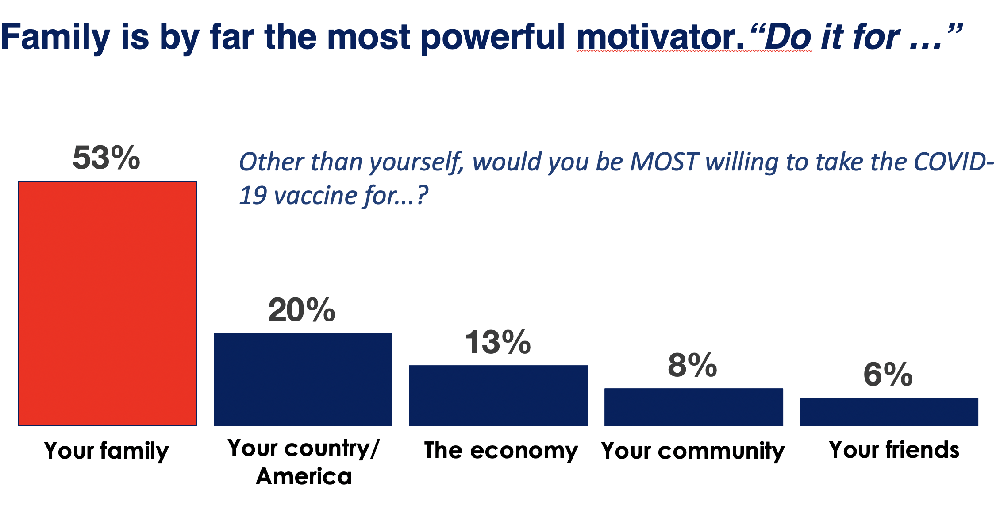The findings of a new national poll, “The Language of Vaccine Acceptance,” reveal the urgent need for political and health leaders to adjust their messaging to improve confidence in COVID-19 vaccines. The poll identifies the language that will be most effective in reaching all Americans, especially those who are currently less likely to take a vaccine, including rural Americans, Republicans age 18-49, Black Americans 18-49, and women 18-49.
The nationwide poll was conducted by the de Beaumont Foundation and pollster Frank Luntz in partnership with the American Public Health Association, the National Collaborative for Health Equity, and Resolve to Save Lives, an Initiative of Vital Strategies. “The divides along racial, urban-rural, political, and generational lines are significant when it comes to vaccine acceptance,” Luntz said, “but we’ve learned that there are certain words and phrases that will work for all audiences.”
Brian C. Castrucci, DrPH, President and CEO of the de Beaumont Foundation, said, “Words can save lives. Our ability to boost confidence in COVID-19 vaccines will depend largely on the language, the messengers, and methods we use to communicate to Americans that the vaccine will help keep them and their families safe and healthy.”
Highlights of Poll Findings:
- Sixty percent of Americans said they were either “absolutely certain” or would “probably” get the vaccine if they could now.
The groups least likely to say they were “absolutely certain” were Americans in rural/farm communities (26%), Republicans age 18-49 (27%), Black Americans 18-49 (28%), and women 18-49 (29%). This compares with 41% of all respondents who said they were “absolutely certain” they would get the vaccine. - When asked about the biggest concern about taking the COVID-19 vaccine, one-third of all respondents (33%) said either long-term side effects or short-term side effects. The top three statements about side effects they found most reassuring were “the likelihood of experiencing a severe side effect is less than 0.5%,” mild side effects “are normal signs that their body building protection,” and “most side effects should go away in a few days.”
- When asked what they want most from a vaccine, respondents said “a return to normal,” followed by “safety” and “immunity.”
- When asked which statement was the most convincing, 62% of respondents chose “getting vaccinated will help keep you, your family, your community, the economy, and your country safe and healthy” over “taking the vaccine is the right thing to do for yourself, for your family, your community, the economy, and the country” (38%). This highlights the need to avoid moralizing and lecturing Americans regarding the importance of vaccine acceptance.
- Family is the most powerful motivator for vaccine acceptance. Significantly more Americans said they’d be most willing to take the vaccine for their family as opposed to “your country,” “the economy,” “your community,” or “your friends.”
- The most convincing reasons to take the vaccine were “at 95 percent efficacy, this vaccine is extraordinarily effective at protecting you from the virus” and “vaccines will help bring this pandemic to an end,” and “getting vaccinated will help keep you, your family, your community, and your country healthy and safe.”
“There is no one-size-fits-all approach when it comes to vaccine communication,” said Georges C. Benjamin, MD, Executive Director of the American Public Health Association. “These poll findings will help us create a roadmap for reaching people who are worried about the COVID-19 vaccine, including communities of color, who are most affected by the pandemic.”

Tips to Promote Vaccine Acceptance
This poll highlights the urgent need to change our vaccine lexicon in order to help bridge key differences and rally Americans across the country toward vaccine acceptance.
Key findings include:
- Tailor your messages for your audience.
- Explain the benefits of getting the vaccine, not just the consequences of not taking it. Focus on the need to return to normal and reopen the economy.
- Talk about the people behind the vaccine. Refer to the scientists, the health and medical experts, and the researchers – not the science, health, and pharmaceutical companies.
- Avoid judgmental language when talking about or to people who are worried about taking a vaccine. Acknowledge their concern or skepticism and offer to answer their questions.
- Black and Latinx Americans are more motivated than the general population by the potential to stop wearing masks.
- Latinx respondents were the only group more motivated by the statement that taking the vaccine is “the right thing to do” than by “getting the vaccine will keep your family and friends healthy and safe.”
Messages for Most Hesitant Groups
Following are highlights of poll findings to inform effective messaging for rural Americans, young Republicans, Black Americans, and women:
- Americans in rural/farm communities have much less confidence in the safety of the vaccine (39% “a little safe” or “not at all safe” vs. 38% “very safe” or “extremely safe”).
- The generational divide is most pronounced among Black Americans regarding what outcome matters most in this pandemic. “Returning to normal” is the desired outcome among Black Americans under 50. But for those over 50, saving lives is the highest priority.
- The top priority for young Republicans is a “return to normal.” The next highest priority is to reopen the economy. Messages about personal health/safety are less impactful.
- For women, the greatest consequence from the pandemic is equally “damage from lockdowns” and the “potential for family/friends to become ill.” Stressing how the vaccine will address both concerns at the same time is important.
Poll Methodology
The nationwide survey was conducted Dec. 21-22 by pollster Frank Luntz, with 1,400 registered voters (+3% margin of error), including an oversample of 300 Black Americans and 300 Latinx Americans. A representative sample of the nation’s demographics, including age, gender, race, education, and income, were polled on the preferred words, sentences, phrases, and attributes that would encourage them to consider taking a COVID-19 vaccine.





